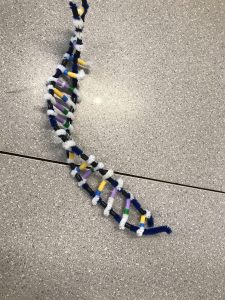- Describe the process of translation: initiation, elongation, termination
initiation: the tRNA comes in with the anti codon pairing to the codon in the mRNA strand, which is held onto by a ribosome. each three letter codon is then attached with the corresponding anti-codon. the starting point is read by the P site, and the corresponding amino acid is then attached.
elongation: the amino acids are continuously added onto the mRNA, and a long chain of amino acids create a protein. the a site reads the next 3 letter chain, and then moves into the p site, and another tRNA is brought in.
termination: the mRNA codon then uses the stop codon to signal the tRNA to stop adding amino acids; there is no tRNA for the stop codon. the ribosome lets go of the mRNA, and then the tRNA lets go of the polypeptide.
2. How did today’s activity model translation? in what ways was it inaccurate?
it was accurate because we physically had to move the ribosome, and the tRNA from a site to p site. plus, we were also able to see a chain of amino acids forming, which is what creates proteins. the most inaccurate parts of the lab were the fact that the shapes of the amino acids and tRNA and mRNA were most likely not how the real things look.
how is mRNA different from DNA?
DNA is made up of deoxyribose sugar but mRNA is made up of ribose sugar. DNA has thymine as one of the two pyrimidines while mRNA has uracil as its pyrimidines base.
describe the process of transcription
Initiation:
- RNA polymerase binds to DNA at a specific sequence of nucleotides

Elongation:
- Only one of the unmound DNA strands acts as a template for the RNA

Termination:
- RNA polymerase continues to elongate until it reaches the terminator, a specific sequence of nucleotides that signals the end of transcription

in what way was our model inaccurate? how did it do a good job?
the models we made were in accurate because they did not exactly show properly how transcription takes place with the unwinding mid way down he strand, but it did show the helicase and the polmerase which is accurate.
When does DNA replication occur?
replication occurs before cell division.
Name and describe the three steps in DNA replication. Why does the process occur differently on the leading and lagging strands?
1- the helicase unzips and unwinds the dna helix

2- the polmerase does complimentary base pairing for the lagging strand

3- the ligase moves and pairs nucleotides on the adjacent strand

the process is different on the lagging strand because the 5′ 3′ pattern is flipped and the ligase has to work backwards with rna primase
3. what did you do to show complimentary base pairing? how was this activity good/bad?
to show the base pairing on the adjacent strand and the regular strand, we used the corresponding beads from the leading strand to pair with the lagging strand. this activity was good because it showed the basic steps of replication, but it did not go into depth, which i believe would be more helpful.
- Explain the structure of DNA – use the terms nucleotides, antiparallel strands, and complimentary base pairing.
DNA is a double helix structure, composed of backbones of sugars and phosphates. on one side, the sugars and phosphates are in a repeating pattern, and on the other backbone, they are anti-parallel reciprocating the opposite way. between the to backbones, there are nucleotides that make a ladder-like form, and the nucleotides pair up using complimentary base pairing here A-T, and C-G. A – adenine. T – thymine. C – cytosine. G –
- How does this activity help model the structure of DNA? What changes could we make to improve the accuracy of this model? Be detailed and constructive.
This activity is very helpful in showing the twisted helix shape of the DNA strands, and putting the nucleotides on ourselves onto the strands was cool. I think that if there were beads to show the sugars and the phosphates would be better because here on our strand we only see the phosphates, and we can’t truly see the anti parallel patterns of the backbones. for example we could use red beads as the sugars so they contrast with the black phosphate beads. it would more accurately show the antiparallel structure.

the dna strand fully coiled into a double helix shape





